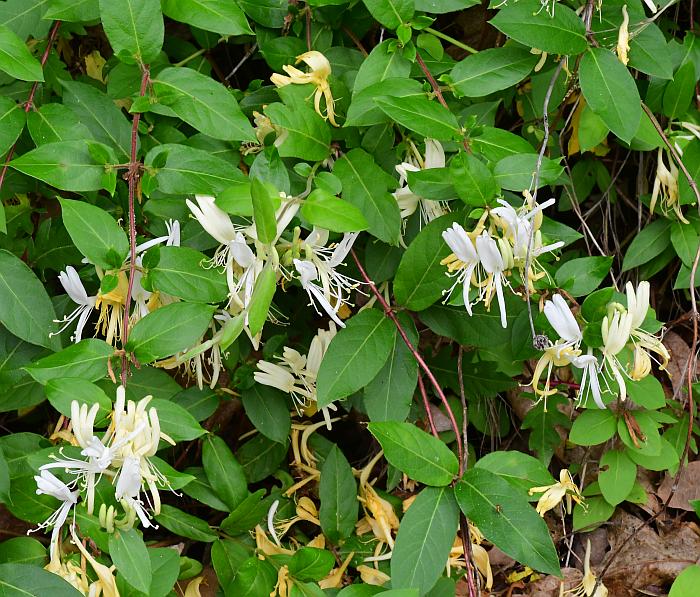Lonicera japonica Thunb.
Japanese Honeysuckle

Introduced
CC = *
CW = 3
MOC = 51
© SRTurner
Lonicera japonica Thunb.Japanese Honeysuckle | |
 |
Introduced CC = * CW = 3 MOC = 51 |
© SRTurner |
|
Family - Caprifoliaceae Habit - Lianas to 5 m or more long. Stems - Loosely twining, climbing on adjacent vegetation or trailing on the ground, sometimes rooting at nodes. Twigs sparsely to moderately pubescent with spreading hairs, sometimes some of these with minutely glandular tips, the pith hollow, the bark of older branches becoming shredded. Winter buds conical, densely hairy.
Leaves - Opposite, sessile or petiolate. Petioles to 1 cm long, pubescent. Blades mostly 3-9 cm long, 1.5-4.5 cm wide, ovate to oblong-elliptic, rounded or angled to short-tapered at the base, angled or tapered to a sharply pointed tip, none perfoliate, the upper surface glabrous or more commonly short-hairy along the midvein, bright green to olive green, the undersurface sparsely to moderately pubescent with short, soft hairs mostly along the main veins, occasionally also with scattered stiffer hairs, not glaucous.
Inflorescences - Flowers paired leaf axils on current year's growth, each pair at the tip of a stalk 1-25 mm long, the 2 bracts each 3-15 mm long, free, ovate to oblong-elliptic, leaflike, hairy, the pair of bractlets on opposite sides of each flower minute (0.7-1.2 mm long), free, oblong-ovate to nearly circular, hairy along the margins.
Flowers - Calyces hairy along the margins, the lobes 0.7-1.5 mm long, triangular to narrowly triangular, green, sometimes purplish-tinged. Corollas 30-47 mm long, strongly zygomorphic, divided about 1/2 of the way to the base into 2 recurved-curled lips of about equal length, the upper lip shallowly 3-lobed, the lower lip with 2 deeper lobes, the tube slender and not swollen or pouched near the base, white, turning cream-colored or pale yellow after pollination, usually hairy and stalked-glandular on the outer surface. Stamens 4, adnate at apex of corolla tube. Filaments to 2.7 cm long, glabrous, white. Stamens and style exserted from the corolla, slightly longer than the corolla lobes, the style glabrous. Stigma green, capitate, subglobose. Ovaries free.
Fruits - Berries 5-8 mm in diameter, black at maturity.
Flowering - April - July. Habitat - Forests, streambanks, pond margins, fencerows, fields, old homesites, railroads, roadsides, and mostly shaded disturbed areas. Also cultivated. Origin - Native to Asia. Lookalikes - Other species of Lonicera have similar flowers. This is the only Missouri species which forms vines and lacks perfoliate leaves and whorls of flowers at branch tips. Other info. - In Missouri this is an invasive weed, perhaps as objectionable as the notorious Amur honeysuckle. It rapidly forms dense mounds and carpets, smothers other plants, and sometimes girdles shrubs and trees by winding around their trunks. It is dispersed by birds, which eat the berries, and also spreads by woody rhizomes. It is found statewide, sometimes as an escape from cultivation. The plant is recognized by its vining habit and characteristic flowers, which are abundant and highly fragrant. Unlike native species, which are relatively less common, L. japonica never produces perfoliate leaves or whorls of flowers at branch tips. Photographs taken at the Kansas City Zoo, 7-8-99, and in Brown Summit, NC., 10-12-02 and 5-16-03 (DETenaglia); also at Riverfront Park, Washington, Franklin County, MO, 11-10-2019, and Holly Ridge Conservation Area, Stoddard County, MO, 5-23-2022 (SRTurner). |